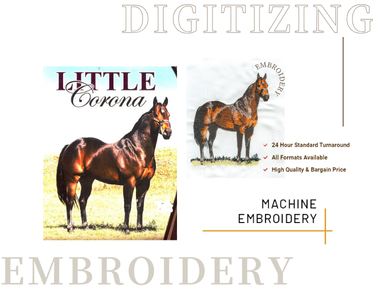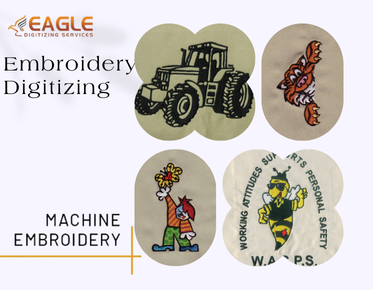The Price Puzzle: Why Screen Printing Costs So Much/Eagle Digitizing
Screen printing is an age-old technique that's beloved for its vibrant colors and durability. But anyone who's ever tried to get custom shirts or posters made knows that it can be quite pricey. So, what exactly makes screen printing so expensive? Let's dive into the various factors that contribute to the costs involved in this intricate process. If this post spurred your interest and you want to find out more about vector artwork conversion, please feel free to contact us.
Initial Setup Costs
Creating the Screens: A Detailed Process
The first step in screen printing is creating the screens. This involves coating a mesh screen with a light-sensitive emulsion, allowing it to dry, and then exposing it to UV light through a film positive of the design. Areas that are exposed to light harden, while the unexposed parts are washed away, resulting in a stencil. This intricate process is labor-intensive and requires precision.
Cost of Emulsion and Other Materials
Emulsion, squeegees, mesh screens, and films are essential materials. High-quality emulsion ensures crisp details but comes at a higher cost. Additionally, each color in the design necessitates a separate screen and emulsion application, adding to the overall expense.
Designing and Preparing Artwork
Professional artwork preparation is crucial. Designs must be vectorized and color-separated, often requiring graphic design expertise. The complexity of the design directly influences the preparation costs.
Equipment Investment
Essential Screen Printing Machines
A professional screen printing setup includes a press, exposure unit, drying rack, and washout booth. Each piece of equipment is essential for different stages of the printing process, ensuring precision and efficiency.
Cost Breakdown of Quality Equipment
Investing in quality equipment is necessary for consistent results. A good manual press can cost anywhere from a few hundred to several thousand dollars, while an automatic press can run into tens of thousands. Exposure units and other essential gear also add to the upfront costs.
Maintenance and Replacement Costs
Regular maintenance is key to prolonging the life of the equipment. This includes replacing worn-out squeegees, and mesh screens, and ensuring the press remains calibrated. These ongoing expenses contribute to the overall cost of screen printing.
Labor and Expertise
Skilled Labor Requirements
Screen printing is an art form that requires skilled labor. Experienced printers understand the nuances of ink viscosity, pressure, and curing times. Their expertise ensures high-quality prints but comes at a premium.
Training and Experience Needed
Training new employees takes time and resources. Mastering screen printing techniques and troubleshooting common issues requires significant experience, adding to labor costs.
Time-Intensive Processes
From setting up screens to drying and curing prints, screen printing is time-intensive. Each step requires careful attention to detail, contributing to the higher costs associated with this method.
Ink and Supplies
Types of Inks Used in Screen Printing
Different projects require different types of inks, such as plastisol, water-based, or discharge inks. Each type has its unique properties and costs, affecting the overall pricing of the printing job.
Price Comparison of Different Inks
Plastisol inks are durable and widely used, but they can be more expensive than water-based inks. However, water-based inks often require more expertise and special handling, to balance out the cost differences.
Additional Supplies: Squeegees, Pallets, and More
Other essential supplies include squeegees, pallets, and cleaning solutions. High-quality squeegees are crucial for smooth ink application, while well-maintained pallets ensure consistent prints.
Quality Control and Testing
Importance of Test Prints
Test prints are necessary to ensure color accuracy and alignment before running the full batch. This step helps avoid costly mistakes but adds to the labor and material costs.
Ensuring Consistency in Large Orders
Maintaining consistency across large orders is challenging. Regular quality checks and adjustments are needed to ensure each print meets the desired standards, increasing labor and material usage.
Costs Associated with Quality Control
Quality control involves additional labor and materials, such as test prints and inspections. Ensuring high-quality results requires meticulous attention, contributing to the overall expense.
Customization and Complexity
Cost of Custom Designs
Custom designs require extra time and expertise to prepare. Each unique design involves creating new screens and adjusting the press setup, increasing costs.
Adding Multiple Colors: More Screens, More Money
Each color in a design requires a separate screen, increasing the time and materials needed. Complex, multicolored designs can significantly raise the price due to the additional screens and setup required.
Complex Designs vs. Simple Prints
Simple, single-color designs are less costly than intricate, multicolored ones. The complexity of the design directly impacts the preparation time and material costs, influencing the final price.
Volume and Production Runs
Small Runs vs. Large Runs: Cost Differences
Small production runs often have higher per-unit costs due to the fixed setup expenses spread over fewer items. Larger runs benefit from economies of scale, reducing the per-unit cost.
How Order Size Affects Pricing
Bulk orders typically receive discounts as the cost of setup and preparation is distributed across more units. Smaller orders can't take advantage of this, resulting in higher costs per item.
Economies of Scale in Screen Printing
Screen printing benefits from economies of scale, where larger orders reduce the cost per unit. This principle helps explain why small orders are relatively more expensive.
Environmental Considerations
Eco-Friendly Inks and Materials: Are They More Expensive?
Eco-friendly inks and materials are gaining popularity but often come with higher price tags. The cost of sustainable products can add to the overall expense of screen printing.
Waste Management and Disposal Costs
Proper disposal of inks and chemicals is essential for environmental compliance. These waste management practices add to the operational costs of a screen printing business.
Sustainable Practices in Screen Printing
Implementing sustainable practices, such as recycling and reducing waste, can incur additional costs. However, these practices are increasingly demanded by eco-conscious consumers.
Market Demand and Pricing
How Demand Influences Prices
High demand for screen printing services can drive up prices. Seasonal spikes, such as during holidays or event seasons, often see increased pricing due to higher demand.
Comparing Prices Across Different Markets
Prices can vary significantly across different markets. Urban areas with higher living costs typically have higher prices for screen printing services compared to rural areas.
Seasonal Trends in Screen Printing
Demand for screen printing can be seasonal, with peaks during certain times of the year. These fluctuations can influence pricing as businesses adjust to the varying demand levels.
Comparison to Other Printing Methods
Screen Printing vs. Digital Printing
Screen printing and digital printing each have their advantages. Screen printing is ideal for large, vibrant designs on various substrates, while digital printing excels in detail and small runs.
Price Differences Between Printing Techniques
Digital printing often has lower setup costs but higher per-unit costs for large runs. Screen printing, while more expensive initially, becomes cost-effective for bulk orders.
Pros and Cons of Each Method
Screen printing offers durability and vibrancy but is labor-intensive and costly for small orders. Digital printing provides high detail and efficiency for short runs but may lack the durability of screen prints.
Hidden Costs and Overheads
Studio Rental and Utilities
Operating a screen printing business involves overhead costs like studio rental and utilities. These fixed costs contribute to the overall pricing structure.
Insurance and Business Licenses
Insurance and business licenses are necessary for legal compliance and protection. These costs are part of the business's operational expenses and affect pricing.
Miscellaneous Costs: Cleaning Supplies, Packaging, etc.
Miscellaneous costs, including cleaning supplies, packaging, and shipping, add up. These often-overlooked expenses contribute to the final price of screen printing services.
Customer Expectations and Custom Service
Personalized Service Costs
Providing personalized services, such as custom designs and one-on-one consultations, adds to the labor and time costs. These premium services justify higher prices.
Handling Customer Revisions and Changes
Revisions and changes requested by customers require additional time and resources. Accommodating these adjustments increases the overall cost of the project.
Quality Guarantees and After-Sales Service
Offering quality guarantees and after-sales services, such as reprints or refunds, adds to the business's costs. These services are important for customer satisfaction but come with a price.
Impact of Technology
Advances in Screen Printing Technology
New technologies in screen printing can improve efficiency and quality. However, investing in the latest equipment involves significant costs, impacting pricing.
Cost of Upgrading Equipment
Upgrading to new, more efficient equipment requires substantial investment. These costs are often passed on to the customer through higher service prices.
Balancing Technology Investment with Pricing
Businesses must balance the cost of technological investments with competitive pricing. While new technology can enhance quality and speed, it must also be economically viable.
Regional Price Variations
How Location Affects Screen Printing Costs
Geographical location affects screen printing costs due to differences in labor, rent, and material prices. Urban areas typically have higher operational costs than rural regions.
Comparing Prices in Urban vs. Rural Areas
Urban screen printing businesses face higher overheads, leading to higher prices. In contrast, rural businesses may offer lower prices but could lack access to the same level of technology and materials.
International Price Differences
International price differences are influenced by factors such as local labor costs, material availability, and economic conditions. These variations affect the global pricing landscape for screen printing services.
Tips for Reducing Screen Printing Costs
Efficient Design and Preparation Tips
Streamline your design and preparation process to save time and money. Simplifying designs, reducing colors, and optimizing screen use can lower costs.
Bulk Ordering and Group Discounts
Bulk ordering reduces the per-unit cost by spreading setup expenses over more items. Group discounts for large orders can also offer significant savings.
Choosing the Right Materials to Save Money
Selecting cost-effective materials without compromising quality can reduce expenses. Researching suppliers and comparing prices helps in finding the best deals.
Understanding Quotes and Invoices
Breaking Down a Screen Printing Quote
A detailed quote breaks down the costs for each aspect of the project, from design preparation to final printing. Understanding these components helps in evaluating the fairness of the pricing.
What to Look for in a Detailed Invoice
A detailed invoice should itemize all charges, including setup fees, materials, labor, and any additional services. Transparency in invoicing helps avoid unexpected costs.
Avoiding Hidden Fees and Surprises
Clear communication with the printer about potential extra costs, such as rush fees or additional revisions, helps avoid surprises. Ensure all terms are agreed upon upfront to prevent hidden charges.
Screen printing's costs are influenced by a myriad of factors, from
initial setup and equipment to labor, materials, and market demand.
Eagle Digitizing offers vector graphics conversion services. While the
process is undoubtedly expensive, the quality and durability of
screen-printed products often justify the price. By understanding the
intricacies of screen printing costs, consumers and businesses alike can
make informed decisions and appreciate the value behind each print.
Exploring efficient practices and staying updated with industry trends
can help you navigate the costs and invest wisely in this timeless
printing method.



